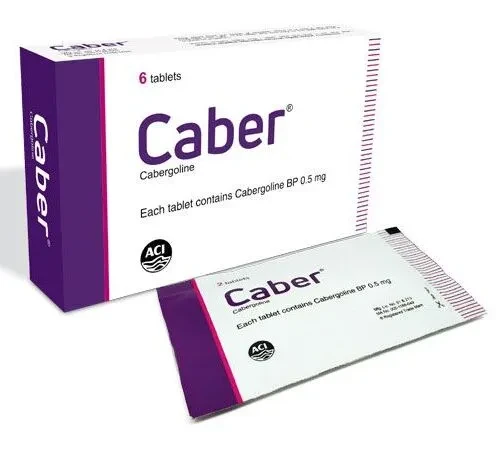Unit Price:
৳ 80.00
(3 x 2: ৳ 480.00)
Strip Price:
৳ 160.00
Indications
Caber is used to stop breast milk production (lactation) soon after childbirth, stillbirth, abortion or miscarriage. It can also be used if do not want to continue to breastfeed. Caber can also be used to treat other conditions caused by hormonal disturbance which can result in high levels of prolactin being produced.
Description
Caber is in a group of drugs called dopamine receptor agonists. It works by reducing the amount of prolactin (a hormone) that is released from the pituitary gland. Caber is used to treat a hormone Imbalance in which there is too much prolactin in the blood (also called hyperprolactinemia).
Pharmacology
Cabergoline is a dopamine receptor agonist. The secretion of prolactin by the anterior pituitary is mainly under hypothalamic inhibitory control, likely exerted through release of dopamine by tuberoinfundibular neurons. Cabergoline is a long acting dopamine receptor agonist with a high affinity for D2 receptors. Results of in vitro studies demonstrate that Cabergoline exerts a direct inhibitory effect on the secretion of prolactin by rat pituitary lactotrophs. Cabergoline decreased serum prolactin levels in reserpinized rats. Receptor binding studies indicate that Cabergoline has low affinity for dopamine D1, α1 and α2 adrenergic and 5HT1, 5HT2 serotonin receptors.
Dosage & Administration
The recommended dosage of Cabergoline for initiation of therapy is 0.25 mg twice a week. Dosage may be increased by 0.25 mg twice weekly up to a dosage of 1 mg twice a week according to the patient’s serum prolactin level. Dosage increases should not occur more rapidly than every 4 weeks, so that the physician can assess the patient’s response to each dosage level. If the patient does not respond adequately and no additional benefit is observed with higher doses, the lowest dose that achieved maximal response should be used and other therapeutic approaches considered. After a normal serum prolactin level has been maintained for 6 months, Cabergoline may be discontinued, with periodic monitoring of the serum prolactin level to determine whether or when treatment with Cabergoline should be reinstituted.
- To prevent milk production (lactation): 1 mg Cabergoline tablet on the first day after delivery.
- To stop lactation once have started to breastfeed: 0.25 mg Cabergoline tablet every 12 hours for two days.
- To reduce prolactin levels in other conditions: Initially take one Cabergoline 0.5 mg tablet (to be taken in two doses) spread out over a week (e.g., half a tablet on Monday and the other half of the tablet on Thursday). Dose will be increased up to a maximum dose of 4.5 mg or until have responded fully to treatment.
Interaction
Medicines to lower blood pressure Medicines used to treat mental illness (e.g. antipsychotic medicines like
chlorpromazine, haloperidol) Medicines for nausea and vomiting (e.g. domperidone, Medicines for severe migraine headaches (e.g. pergolide, metoclopramide, bromocriptine, lisuride, ergotamine, dihydroergotamine, ergometrine or methysergide)
chlorpromazine, haloperidol) Medicines for nausea and vomiting (e.g. domperidone, Medicines for severe migraine headaches (e.g. pergolide, metoclopramide, bromocriptine, lisuride, ergotamine, dihydroergotamine, ergometrine or methysergide)
Contraindications
History of serious mental disease, particularly psychotic disorders Liver or kidney disease High blood pressure in
pregnancy associated with swelling and protein in the urine (toxaemia of pregnancy) Antipsychotic or have a history of mental illness associated with child-birth (puerperal psychosis).
pregnancy associated with swelling and protein in the urine (toxaemia of pregnancy) Antipsychotic or have a history of mental illness associated with child-birth (puerperal psychosis).
Side Effects
Pregnant or planning to get pregnant, women must discuss with doctor before treatment though Caber is pregnancy category B. Pregnant for at least one month, one should stop taking Caber, as Caber will stop producing milk. If someone plan to breastfeed should not take Caber.
Pregnancy & Lactation
Pregnant or planning to get pregnant, discuss this with doctor before treatment though the pregnancy category B. Before start using Cabergoline check that patient not pregnant. Pregnant for at least one month once have
stopped taking Cabergoline, As Ferticab will stop producing milk.If someone plan to breastfeed should not take Cabergoline.
stopped taking Cabergoline, As Ferticab will stop producing milk.If someone plan to breastfeed should not take Cabergoline.
Precautions & Warnings
- Hypersensitive (allergic) to Caber, to other medicines called ergot alkaloids, (e.g. pergolide, bromocriptine, lisuride, ergotamine or ergometrine) or to any of the other ingredients in the tablet
- Severe liver disease
- High blood pressure in pregnancy associated with swelling and protein in the urine (toxaemia of pregnancy)
- Anti-psychotics or have a history of mental illness associated with child-birth (puerperal psychosis)
- Pregnant or breastfeeding
- Treated with Caber for a long period and have or had fibrotic reactions (scar tissue) affecting your heart
Overdose Effects
Overdosage might be expected to produce nasal congestion, syncope or hallucinations. Measures to support blood pressure should be taken if necessary.
Therapeutic Class
Antiparkinson drugs
Storage Conditions
Store in a cool and dry place protected from light. Keep away from the reach of children.


